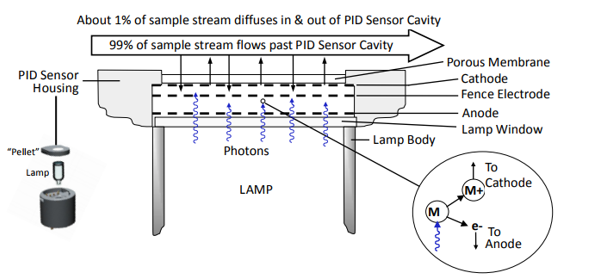Casella UK
Wolseley Rd, Kempston,Bedford MK42 7JY
+44(0)1234844100
info@casellasolutions.com

Figure 1 - PID sensor design
Since the original concept for Casella’s Guardian environmental monitoring system as a multi agent monitoring system sending data to the cloud, the latest version, Guardian2, now boasts a smaller form factor (compared with the original design), a bespoke datalogger with telemetry and solar power and battery options. ‘Agents’ include user definable combinations of noise, particulate (simultaneous PM1, PM2.5, PM10), ground vibration, wind speed & direction and now volatile organic compounds (VOC). But why is this latest development so significant?
According to professional services firm, Pricewaterhouse Coopers (PwC) 1, our future is set to be urban. They say that more than half the world’s population already live in urban area and that 1.5 million people are added to the global urban population every week. PwC have estimated that $78 trillion will be invested in global infrastructure over the next 10 years to accommodate this growth and major cities like New York, Beijing, Shanghai and London will need $8 trillion in infrastructure investments alone. So what does this mean for the land needed to support this? Clearly much of the land available for development is brownfield, an Anglo-American term used in urban planning to describe any previously developed land that is not currently in use, whether contaminated or not. In North America, it more specifically describes land previously used for industrial or commercial purposes with known or suspected pollution including soil contamination due to hazardous waste.
Urban regeneration (revitalization in the US) is a common strategic objective for Governments and Cities alike. Take the London 2012 Olympics as a prime example. The enabling works cleaned up an area of East London which was heavily contaminated as a result of former industrial activity. Previous uses since Victorian times included landfilling, a soap factory, gas works and a number of heavy industrial operations. It involved demolishing 190 buildings, construction of 30 new bridges and soil washing over 600,000 tons of soil. Contaminants of most concern included heavy metals (lead, arsenic and chromium), as well as organics (such as fuel oil, tar and bitumen), ammonia and localised chlorinated hydrocarbons.
Environmental Consultants deployed multiple Casella noise and dust monitoring instruments in semi-permanent, battery powered enclosures as forerunners to the Guardian, while hand-held photoionization detectors (PID) were used for VOCs and hydrocarbons.
Remediation (the action of reversing or stopping environmental damage) and health risk assessment are increasingly required by both industry and property developers as more is understood about risks from contaminated land, and regulations increasingly become more stringent. Remediation of an industrial site may be required when an environmental permit is surrendered, or following an accidental release of pollutants to land. Similarly it is often required in order to obtain planning permission and develop the site.
Contaminated land projects for planning usually require an initial ground evaluation, followed by a human health risk assessment using an appropriate model. Remediation can vary from removal of all contaminated materials, through using various chemical and biological treatments for contaminated soil and groundwater, to leaving contamination in place and containing it, or monitoring its dispersion. Timescales can take anything from several days or weeks to several years and costs can be dramatically different depending on the type of techniques used. A long-term community or perimeter air monitoring programme (CAMP/PAMP) is often mandated to protect local residents and the wider environment.
Focussing on the measurement of VOCs, Figure 1 is a schematic of the proprietary PID sensor system used in Guardian2. A UV lamp generates high-energy photons, which pass through the lamp window and into the sensor chamber. Ambient air is pulled over the sensor and about 1% of it diffuses through a porous membrane into the other side of the sensor chamber. The inset on the lower right of figure 1 shows what happens on a molecular level. When a photon with enough energy strikes a molecule M, an electron (e-) is ejected. M+ ion travels to the cathode and the electron travels to the anode, resulting in a current proportional to the VOC concentration. The electrical current is amplified and displayed as a part per million (ppm) or part per billion (ppb) concentration. Not all molecules can be ionized. Conveniently, the major components of clean air i.e. nitrogen, oxygen, carbon dioxide, argon, etc., do not cause a response, but most VOCs do give a ‘broadband’ response.
References
1. https://www.pwc.co.uk/issues/megatrends/rapid-urbanisation.html